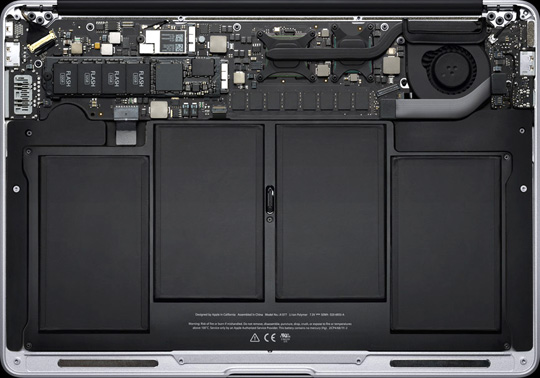This article is more than 1 year old
Apple MacBook Air 13in late 2010
Boots in a flash, but you'll need a lot of cash
One aspect of the Air that many will view as no great loss at all is the absence of the flip open door that would house various ports. The new shape allows for two USB ports – one on each side – with a mic grille, headphone output and magnetic power adapter also featured on the left, with the DisplayPort and SD card slot appearing on the right.

Headphone output, but just a mic input – on the other side, the 13in models feature an SD card slot
The 13.3in glossy screen is far from being a distracting mirror that features on other MacBook models that have a panel extending to the edge of the lid. The MacBook Air’s display bezel is more akin to those MacBooks that feature the antiglare screen, having a metal margin around the panel.
The screen itself, while not as dazzling as those offered on a MacBook Pro, is certainly bright and crisp. It’s also a higher resolution than previous models and, at 1440 x 900, it even beats the 13.3in MacBook Pro (1280 x 800) and matches the 15in model. Furthermore, one of the hardware tweaks is the GPU. This is now an Nvidia GeForce 320M with 256MB of DDR3 SDRAM shared with the main memory and is featured across all new Air models.
On the subject of chippery, the entry-level 13in MacBook Air on review here has the same 1.86GHz Intel Core 2 Duo SL9400 CPU as with the previous model. Also, like its predecessor, there is a 2.13GHz (SL9600) option. However, where previously memory was fixed at 2GB, for £80 you can now upgrade any new MacBook Air from its standard 2GB DDR3 SDRAM configuration to 4GB, as a build to order option.
The portability of the MacBook Air has to be experienced to be fully appreciated. Having personally gone with the desktop replacement 17in MacBook Pro 18 months ago, using the lightweight Air was quite a contrast, but not in ways I’d expected. With both the keyboard and the trackpad the same size, there were no awkward compromises in usability. As a portable, its low mass was probably the most obvious difference, as it freely wobbled around on the lap, where rather heavier beasts would typically stay put.

The thin end of the wedge is given over to battery cells
Travelling with the Air in a backpack was barely noticeable too, and having no designer zip case to hand, a Jiffy bag turned out to be just as effective. Indeed, slipping the sleeping Air out of the bag when using it throughout the day, is much the same as opening a letter – waking from sleep is under two seconds and is near instantaneous. Apple wants to deliver the iPad ‘instant on’ experience to the laptop and has pretty much succeeded. With no waiting around for a hard disk to spin up and Wi-Fi connectivity from the off, it’s hard not to be impressed. Even if the boot up time isn’t exactly instant on, it’s anything but tardy.
